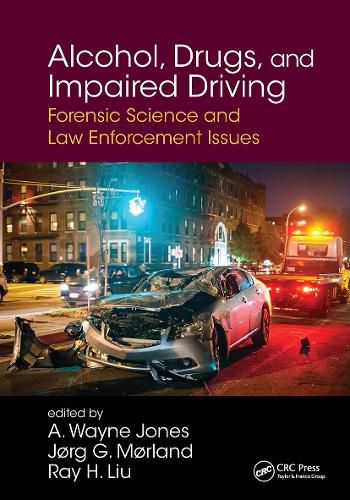Readings Newsletter
Become a Readings Member to make your shopping experience even easier.
Sign in or sign up for free!
You’re not far away from qualifying for FREE standard shipping within Australia
You’ve qualified for FREE standard shipping within Australia
The cart is loading…






Alcohol, Drugs, and Impaired Driving addresses many theoretical and practical issues related to the role played by alcohol and other psychoactive drugs on driving performance, road-traffic safety, and public health. Several key forensic issues are involved in the enforcement of laws regulating driving under the influence of alcohol and/or other drugs, including analytical toxicology, pharmacology of drug action, as well as the relationships between dose taken, concentration levels in the body, and impairment of performance and behavior. Our knowledge of drunken driving is much more comprehensive than drugged driving, so a large part of this book is devoted to alcohol impairment, as well as impairment caused by use of drugs other than alcohol.
For convenience, the book is divided into four main sections. The first section gives some historical background about measuring alcohol in blood and breath as evidence for the prosecution of traffic offenders. The important role of the Breathalyzer instrument in traffic-law enforcement, especially in Australia, Canada, and the USA is presented along with a biographical sketch of its inventor (Professor Robert F. Borkenstein of Indiana University) with focus on the man, his work and his impact. The second section discusses several issues related to forensic blood and breath-alcohol alcohol analysis as evidence for prosecution of traffic offenders. This includes how the results should be interpreted in relation to impairment and an evaluation of common defense challenges. Because most countries have adopted concentration per se laws, the main thrust of the prosecution case is the suspect's measured blood- or breath-alcohol concentration. This legal framework necessitates that the analytical methods used are "fit for purpose" and are subjected to rigorous quality assurance procedures. The third section gives a broad overview of the current state of knowledge about driving under the influence of non-alcohol drugs in various countries. This includes adoption of zero-tolerance laws, concentration per se statutes, and clinical evidence of driver impairment based on field sobriety tests and drug recognition expert evidence. The fourth section deals with epidemiology, enforcement, and countermeasures aimed at reducing the threat of drunken and drugged driving.
All articles have appeared previously in the international journal Forensic Science Review, but all are completely updated with current data, references, and the latest research on developments since the articles were published. This book contains a convenient collection of the best articles covering recommendations for blood and breath testing methods, public policy relating to such methods, and forensic and legal implications of the enforcement of measures to counter driving under the influence.
$9.00 standard shipping within Australia
FREE standard shipping within Australia for orders over $100.00
Express & International shipping calculated at checkout
Alcohol, Drugs, and Impaired Driving addresses many theoretical and practical issues related to the role played by alcohol and other psychoactive drugs on driving performance, road-traffic safety, and public health. Several key forensic issues are involved in the enforcement of laws regulating driving under the influence of alcohol and/or other drugs, including analytical toxicology, pharmacology of drug action, as well as the relationships between dose taken, concentration levels in the body, and impairment of performance and behavior. Our knowledge of drunken driving is much more comprehensive than drugged driving, so a large part of this book is devoted to alcohol impairment, as well as impairment caused by use of drugs other than alcohol.
For convenience, the book is divided into four main sections. The first section gives some historical background about measuring alcohol in blood and breath as evidence for the prosecution of traffic offenders. The important role of the Breathalyzer instrument in traffic-law enforcement, especially in Australia, Canada, and the USA is presented along with a biographical sketch of its inventor (Professor Robert F. Borkenstein of Indiana University) with focus on the man, his work and his impact. The second section discusses several issues related to forensic blood and breath-alcohol alcohol analysis as evidence for prosecution of traffic offenders. This includes how the results should be interpreted in relation to impairment and an evaluation of common defense challenges. Because most countries have adopted concentration per se laws, the main thrust of the prosecution case is the suspect's measured blood- or breath-alcohol concentration. This legal framework necessitates that the analytical methods used are "fit for purpose" and are subjected to rigorous quality assurance procedures. The third section gives a broad overview of the current state of knowledge about driving under the influence of non-alcohol drugs in various countries. This includes adoption of zero-tolerance laws, concentration per se statutes, and clinical evidence of driver impairment based on field sobriety tests and drug recognition expert evidence. The fourth section deals with epidemiology, enforcement, and countermeasures aimed at reducing the threat of drunken and drugged driving.
All articles have appeared previously in the international journal Forensic Science Review, but all are completely updated with current data, references, and the latest research on developments since the articles were published. This book contains a convenient collection of the best articles covering recommendations for blood and breath testing methods, public policy relating to such methods, and forensic and legal implications of the enforcement of measures to counter driving under the influence.